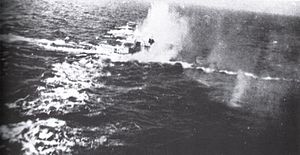
Summary
German submarine U-1065 was a Type VIIC/41 U-boat of Nazi Germany's Kriegsmarine during World War II.
 U-1065 under air attack
| |
| History | |
|---|---|
| Name | U-1065 |
| Ordered | 14 October 1941 |
| Builder | Germaniawerft, Kiel |
| Yard number | 702 |
| Laid down | 23 September 1943 |
| Launched | 3 August 1944 |
| Commissioned | 23 September 1944 |
| Fate | Sunk in air attack north-west of Gothenburg, Sweden on 9 April 1945[1] |
| General characteristics [2] | |
| Class and type | Type VIIC/41 submarine |
| Displacement | |
| Length |
|
| Beam |
|
| Height | 9.60 m (31 ft 6 in) |
| Draught | 4.74 m (15 ft 7 in) |
| Installed power |
|
| Propulsion |
|
| Speed |
|
| Range | |
| Test depth |
|
| Complement | 44-52 officers & ratings |
| Armament |
|
| Service record | |
| Part of: |
|
| Identification codes: | M 43 832 |
| Commanders: |
|
| Operations: |
|
| Victories: | None |
She was ordered on 14 October 1941, and was laid down on 23 September 1943 at Friedrich Krupp Germaniawerft, Kiel, as yard number 702. She was launched on 3 August 1944 and commissioned under the command of Oberleutnant zur See Johannes Panitz on 23 September of that year.[1][2]
Design edit
German Type VIIC/41 submarines were preceded by the heavier Type VIIC submarines. U-1065 had a displacement of 759 tonnes (747 long tons) when at the surface and 860 tonnes (850 long tons) while submerged.[3] She had a total length of 67.10 m (220 ft 2 in), a pressure hull length of 50.50 m (165 ft 8 in), a beam of 6.20 m (20 ft 4 in), a height of 9.60 m (31 ft 6 in), and a draught of 4.74 m (15 ft 7 in). The submarine was powered by two Germaniawerft F46 four-stroke, six-cylinder supercharged diesel engines producing a total of 2,800 to 3,200 metric horsepower (2,060 to 2,350 kW; 2,760 to 3,160 shp) for use while surfaced, two AEG GU 460/8–27 double-acting electric motors producing a total of 750 metric horsepower (550 kW; 740 shp) for use while submerged. She had two shafts and two 1.23 m (4 ft) propellers. The boat was capable of operating at depths of up to 230 metres (750 ft).[3]
The submarine had a maximum surface speed of 17.7 knots (32.8 km/h; 20.4 mph) and a maximum submerged speed of 7.6 knots (14.1 km/h; 8.7 mph).[3] When submerged, the boat could operate for 80 nautical miles (150 km; 92 mi) at 4 knots (7.4 km/h; 4.6 mph); when surfaced, she could travel 8,500 nautical miles (15,700 km; 9,800 mi) at 10 knots (19 km/h; 12 mph). U-1065 was fitted with five 53.3 cm (21 in) torpedo tubes (four fitted at the bow and one at the stern), fourteen torpedoes, one 8.8 cm (3.46 in) SK C/35 naval gun, (220 rounds), one 3.7 cm (1.5 in) Flak M42 and two 2 cm (0.79 in) C/30 anti-aircraft guns. The boat had a complement of between forty-four and sixty.[3]
Service history edit
U-1065 had a very short career. While she was commissioned on 23 September 1944, she was not assigned to a flotilla until 1 April 1945. She spent the intervening six months training with the 5th U-boat Flotilla. At the end of her training, she was formally assigned to the same flotilla. She began her first patrol on 4 April 1945, but was sunk after only six days at sea.[1]
First patrol and loss edit
U-1065's first patrol took her from her home port of Kiel in northern Germany towards occupied Norway.[1] However, while en route to Norway in company with another of the Flotilla's boats, U-804, the two submarines were detected and attacked in the Skagerrak strait by 34 de Havilland Mosquito aircraft from three separate Royal Air Force squadrons.[4] During the attack, U-1065 was able to shoot down one of the Mosquitos with her anti-aircraft guns. However, she was then hit by several rockets from 10 separate Mosquitos from 143 and 235 Squadron; she exploded and sank with the loss of her entire crew of 45 men.[1][4]
The accompanying vessel, U-804, was also hit by rockets from the Mosquitos during the altercation. She exploded and rapidly sank with the loss of her entire crew of 55 men.[5]
See also edit
References edit
- ^ a b c d e Helgason, Guðmundur. "U-1065". German U-boats of WWII - uboat.net. Retrieved 2 March 2010.
- ^ a b Helgason, Guðmundur. "Type VIIC/41". German U-boats of WWII - uboat.net. Retrieved 2 March 2010.
- ^ a b c d Gröner 1991, pp. 43–46.
- ^ a b Helgason, Guðmundur. "U-Boat War in World War II: U-boat successes against aircraft". German U-boats of WWII - uboat.net. Retrieved 2 March 2010.
- ^ Helgason, Guðmundur. "U-Boat War in World War II: U-804". German U-boats of WWII - uboat.net. Retrieved 2 March 2010.
Bibliography edit
- Busch, Rainer; Röll, Hans-Joachim (1999). German U-boat commanders of World War II : a biographical dictionary. Translated by Brooks, Geoffrey. London, Annapolis, Md: Greenhill Books, Naval Institute Press. ISBN 1-55750-186-6.
- Busch, Rainer; Röll, Hans-Joachim (1999). Deutsche U-Boot-Verluste von September 1939 bis Mai 1945 [German U-boat losses from September 1939 to May 1945]. Der U-Boot-Krieg (in German). Vol. IV. Hamburg, Berlin, Bonn: Mittler. ISBN 3-8132-0514-2.
- Gröner, Erich; Jung, Dieter; Maass, Martin (1991). German Warships 1815–1945, U-boats and Mine Warfare Vessels. Vol. 2. Translated by Thomas, Keith; Magowan, Rachel. London: Conway Maritime Press. ISBN 0-85177-593-4.
57°48′N 11°26′E / 57.800°N 11.433°E


